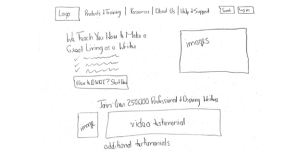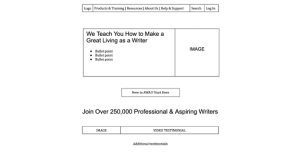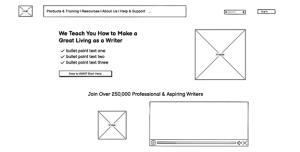Last week, we covered what wireframes are and why they help both copywriters and clients.
Now that you know how useful they are to turn in your web copy, here we’ll cover four different options for how to design wireframes:
- Drawing by hand with pen and paper
- Using a word processing document like Google or Word docs
- Canva
- Balsamiq
We’ll provide an illustrated example and a short explanation of each option, so you can choose the one that works best for you and your clients.
Drawing Your Wireframe by Hand
While there is software you can use to create wireframes for your clients, going old-school is fine if that’s most comfortable for you.
Copywriter Lisa Cumes started this way. She would hand-draw illustrations of the web pages she wrote for her clients. Then she’d take a picture of the drawings and send those pictures to her clients.
Drawing wireframes by hand is a great way to get creative and experiment with ideas. It helps you draw out your thoughts in a visual and tangible way, which can be useful for brainstorming and refining ideas.
Drawing by hand also lets you easily make changes and adjustments and quickly sketch out new ideas.
Even if you create your final wireframes with software, drafting them by hand is widely recommended. It gives you a better understanding of your design, and you can make changes more quickly if necessary.
Here’s an example of what the AWAI homepage might look like if we wireframed it by hand. This portion is what a user would see on a computer before they start scrolling, also known as “above the fold.”

Using a Word Processing Document
Another option for creating your wireframes is with a Google or Word document.
Creating a wireframe in a Google or Word document can be a great way to quickly design a basic structure for your copy.
You can rearrange elements and add comments and annotations. You can collaborate with others in real-time, making it an ideal option for remote teams. Additionally, you can save the document in the cloud, meaning you can always access the latest version from anywhere.
This is an example of the AWAI homepage mocked up in Google docs:

Using Canva
Canva is an online design platform that makes it easy for non-designers to create beautiful visuals for their projects.
Using Canva to design wireframes for your copywriting clients can be a great way to quickly and easily create professional-looking wireframes. While Canva offers a paid subscription option, the free version will work for wireframes.
Canva offers a variety of templates and tools that make it easy to customize your wireframe design, such as adding images, shapes, text, and more.
Additionally, Canva allows you to collaborate with others in real-time, enabling you to quickly make changes and get feedback on your designs.
Finally, Canva makes it easy to export your wireframes in various formats, allowing you to share them with clients or other stakeholders.
Here is an example of the AWAI homepage wireframed in Canva:

Using Balsamiq
Balsamiq is an online wireframing tool that makes creating wireframes for websites, apps, and other projects easy. If you’re looking for a more sophisticated wireframing tool, Balsamiq may be the right option.
Balsamiq offers a wide range of features and tools to create professional wireframes quickly and efficiently.
With Balsamiq, you can easily drag and drop elements from the library of pre-made components, making it easy to create complex wireframes without spending hours coding or designing.
Balsamiq also allows you to collaborate with your clients in real-time, enabling you to make changes and adjustments on the fly.
Finally, Balsamiq offers a wide range of templates and tutorials to help you get started.
This is how the AWAI homepage might look if we used Balsamiq to wireframe it:

Which Tool Is Best?
Use the wireframing tool that works best for your skills and workflow.
My Google doc example is very rudimentary because I have never been good at using word-processing documents for anything other than text.
I wouldn’t attempt to wireframe a client’s project in a document simply because it’s too challenging for me. But someone with more skill might be very comfortable using Google or Word docs to build wireframes.
At the opposite end of the spectrum is Balsamiq, a very robust tool because it’s meant for web designers. There are extra features you would never use as a copywriter.
I found Balsamiq intuitive and easy to use the first time I tried it, even though I had no experience with wireframing. So, don’t be afraid to experiment with it. But if you find Balsamiq too complicated, don’t feel you need to use it.
Final Thoughts on Wireframing Tools
In conclusion, four great options exist for creating wireframes for your copywriting clients. You can draw one with pen and paper or use a word processing document like Google or Word docs. You could also try design tools like Canva or Balsamiq.
Each option has advantages and disadvantages, so it’s important to consider your client’s (and your own) needs before making a decision.
And as a reminder, providing wireframes as part of your copywriting services is not a necessity. Wireframes are a great tool with many benefits to your clients and you, but they’re completely optional.
We hope this blog post has been helpful in giving you an overview of the options available for creating wireframes for delivering your web copy to your clients. Now we’d love to hear from you. Do you offer wireframes with your copy? What tool do you like to use?